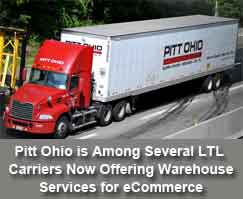US ecommerce sales continue to grow by about 15% year-over-year, quarter after quarter, according to data from the Commerce Dept.
That means a lot of freight is moving - and naturally less-than-truckload (LTL) carriers are looking at how they might tap best into that revenue stream.
Supply Chain Digest Says... |
 |
| The trend towards use of LTL is continuing, as the major parcel carriers keep upping fees to deliver large or irregularly sized merchandise. |
 |
What do you say? |
| Click here to send us your comments |
 |
| Click here to see reader feedback |
|
|
For example, just last week, as LTL giant YRC World announced it has hired Jason Ringgenberg, formerly of Accenture, as its first corporate CIO, he noted that "One of the biggest opportunities today is addressing last-mile deliveries and supporting ecommerce growth."
But how can LTL carriers participate in delivering today overwhelmingly dominate by parcel shipments handled by UPS, FedEx, the United States Postal Service, and perhaps someday soon by Amazon itself?
One obvious opportunity may be to transport larger items such as appliances and furniture that the parcel giants don't handle – a market currently dominated by specialty local delivery firms. But developing those last mile capabilities will often require also offering installation and other services, capabilities a few LTL firms have started to provide.
But there may be another, related path to tapping into the ecommerce opportunity – warehousing services to enable companies to position inventory closer to the customer for final delivery.
As described in an article last week in Transport Topics, the magazine of the American Trucking Associations, a growing number of LTL carriers are adding these capabilities.
"LTLs are starting to take interest in handling e-commerce deliveries of large shipments. For example, delivery of exercise equipment and furniture in a box. LTLs used to ignore it because it often meant residential deliveries, but they're starting to realize that it's an area that is growing and if they ignore it, they miss out on a growth opportunity," Satish Jindel, founder of SJ Consulting Group, told Transport Topics.
LTL carrier A. Duie Pyle is one example of a carrier that has embraced warehousing services.
The carrier noted, for example, that it serves shippers in the hardwood floor sector. Those companies store product in warehouses connected to its LTL terminals, meaning the time from when the shipper sends an order and when it can be loaded on a truck for final delivery is very short.
Pyle also says it is seeing sharp growth in the level of shipments it sees that are less than 500 pounds.
Pitt Ohio is another LTL carrier offering warehouse services, especially for small and mid-sized shippers, Transport Topics says. It says customers will send in a full truckload of popular items to its terminals, which again can be quickly moved onto trucks when customer orders are transmitted.
Pitt Ohio is redesigning current and new terminals to better accommodate storage services, such as increasing the height of roofs to support rack storage.
YRC Worldwide does not have warehousing integrated with its terminals, but does operate three larger warehouses across the US. The carrier is currently evaluating whether to jump into short-term local storage.
A YRC executive says it is seeing a big uptick in ecommerce related orders for "large parcel" items that need to be transported directly to a consumer's home or a storefront, many of which require so-called "white glove" or installation services.
(See More Below)
|
CATEGORY SPONSOR: SOFTEON |
|
|
| |
|
|
 The trend is to not use standard equipment for ecommerce deliveries, carriers say. Many are using Class 5 or 6 level vehicles, rather than Class 8 trucks historically used in LTL pickups and deliveries. The trend is to not use standard equipment for ecommerce deliveries, carriers say. Many are using Class 5 or 6 level vehicles, rather than Class 8 trucks historically used in LTL pickups and deliveries.
Pitt Ohio, for example, has more than 400 straight trucks with liftgates to provide home delivery rather than 28-foot or 53-foot trailers.
Ecommerce already comprises 10% to 20% of deliveries in the $35 billion LTL market, estimated Kevin Zweier, a vice president at supply chain consultancy Chainalytics, in 2016.
That trend is continuing, as the major parcel carriers keep upping fees to deliver large or irregularly sized merchandise. LTL fees can sometimes be just half of parcel shipping costs for goods like appliances or exercise equipment.
But that situation may not last, as LTL carriers are also seeing high costs from ecommerce deliveries and may also be forced to increase charges for residential deliveries to achieve better profitability.
The growth of ecommerce deliveries is also leading many LTL carriers to expand their terminal networks, at great expense, even as overall freight volumes are largely flat.
Will LTL carriers play an increasing role in ecommerce deliveries? What do they need to do? Let us know your thoughts at the Feedback section below.
Your Comments/Feedback
|